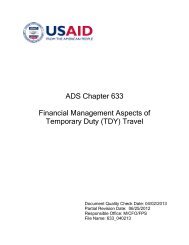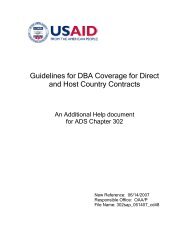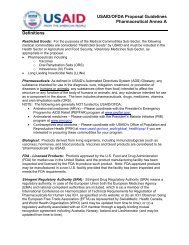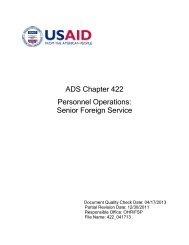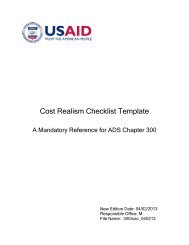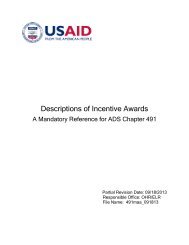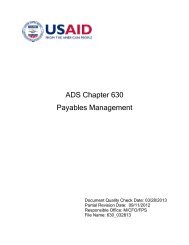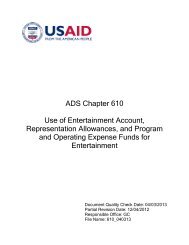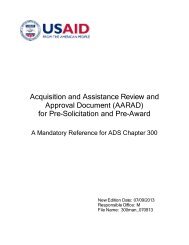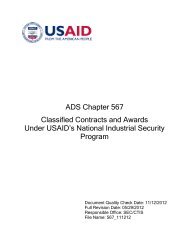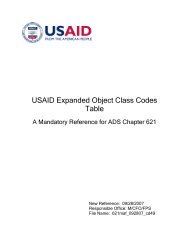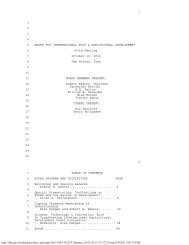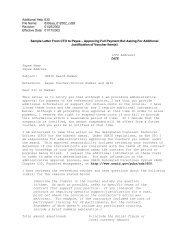CRSP Review Team Letter of Transmittal - usaid
CRSP Review Team Letter of Transmittal - usaid
CRSP Review Team Letter of Transmittal - usaid
Create successful ePaper yourself
Turn your PDF publications into a flip-book with our unique Google optimized e-Paper software.
Shah, page 2August 22, 2012In terms <strong>of</strong> specific recommendations, here are our comments:1) We strongly endorse Recommendation One <strong>of</strong> the study that calls for development <strong>of</strong> anoverarching strategy for engaging US universities in agriculture and food security research, andHICD, which retains the <strong>CRSP</strong>s as a central component. The full range <strong>of</strong> science and technologymust be embraced in the research and HICD programs at USAID, which draws upon a fullpartnership among government agencies, foundations, universities, and private sector entities.The study recognizes this challenge, but does not fully address the means <strong>of</strong> marshaling thesupport and energy that will be needed. USAID field missions must be drawn into dialogue withresearch partners and universities within their countries and within the US in order to insure thatthe latest science and technology addresses new enterprise development and evolving economicand social needs <strong>of</strong>target countries. BIFAD can playa key role in supporting USAID efforts inthis regard.2) We have reservations about Recommendation Two, which would create a Scientific AdvisoryCouncil (SAC) under BIFAD. We concur with the findings behind the recommendation, butquestion whether a SAC is the appropriate response. The BIF AD will give additionalconsideration to how to achieve the goal <strong>of</strong> strategic alignment <strong>of</strong> research and HICD articulatedin the <strong>CRSP</strong> study - the BIF AD itself possesses considerable scientific expertise already that maybe applied to this process. USAID benefits from the Congressional charge <strong>of</strong> the BIFAD and anadditional committee may in some way duplicate efforts. We would not want to see anyrecommendation diminish the potential strength that BIF AD can contribute to USAID. Our sensealso is that the technical demands <strong>of</strong> prioritization are more than a few experts can meet - an adhoc diverse, multi-layered process may be preferable. Further, BIFAD is cognizant <strong>of</strong> the need touse budgetary resources judiciously as we draw upon any additional scientific expertise.3) We also have reservations about Recommendation Three that recommends a Chief Scientist atUSAID/BFS to oversee food security research and HICD and to liaise with an independentadvisory body. While being USAID's prerogative, we would like to consider more fully how theboard would engage with a chief scientist. The BIF AD wishes to more deeply discuss ways toaddress the breadth and depth <strong>of</strong> research knowledge brought to bear in USAID programming.We will be discussing various ideas to achieve this goal- USAID's efforts in building the FtFresearch strategy and USAID's recent experience in the FtF Inception workshops on the groundare commendable, and provide one good model to follow.4) We endorse Recommendation Four that discusses two new <strong>CRSP</strong> models, which address the needboth for globally strategic and country-driven demand approaches. We recognize that the modelsneed to be flexible, as global and national priorities shift.5) We strongly agree with Recommendation Five, which calls for strengthened USAID and <strong>CRSP</strong>management through centralized functions and use <strong>of</strong>technology. A chief scientist or principaldirector might add value here.
Shah, page 3 August 22,2012 6) The BIF AD endorses Recommendation Six to foster and enhance the institutional capacitydevelopment dimension <strong>of</strong><strong>CRSP</strong>s and other USAID/university projects. We do believe, though,that the report underestimates the degree <strong>of</strong> institutional capacity development that has takenplace. The BIFAD study on HICD will shed light on this issue.7) In principle, we concur with Recommendation Seven that calls for a new funding paradigm thataligns funding with development priorities and research strategies. BFS advises that under yourleadership USAlD has already moved to align resources with priorities in support <strong>of</strong> the FtFresearch strategy. BIF AD supports these focused efforts in USAID to develop basic principlesand strategic review processes that will guide realignment and reallocation <strong>of</strong> resources over timeto address priorities among the <strong>CRSP</strong>s. The resulting differential allocation <strong>of</strong> resources among<strong>CRSP</strong>s can then be understood and justified programmatically.8) We endorse Recommendation Eight, which advocates leveraging <strong>CRSP</strong>s with other resources,including private sector partners. The BIF AD is committed to showing leadership in this area,while acknowledging that finding traction on this issue is difficult. The <strong>CRSP</strong>s have provenpowers <strong>of</strong> incentivization to build upon in this regard.9) As to Recommendation Nine, while realizing the need for additional resources, we hesitate torecommend higher funding in the current budget climate. At the same time, it is clear that many<strong>of</strong> the weaknesses among the <strong>CRSP</strong>s stem from lack resources, in particular the objective <strong>of</strong>advancing research, human and institutional capacity with a $3 1.5 annual USAID investment.In closing, one general comment is that the study gives limited attention to how the recommendations willbe implemented, nor is there sufficient focus on impact, which leaves much work to be done. These andother parallel questions before BIF AD present a rich agenda <strong>of</strong> additional work, which we embrace andlook forward to further board discussions regarding these issues.The BIF AD welcomes the opportunity to discuss with you our views about next steps in this process.Also, as we earlier discussed, Dr. Robert J. Jones, <strong>CRSP</strong> Report <strong>Team</strong> leader, and I would welcome ameeting with you and USAID Bureau for Food Security senior management at a mutually convenienttime in September or early October to discuss the report and BIF AD follow-on engagement. Manythanks for your continued support <strong>of</strong> BlF AD.Sincerely,Brady J. Deaton, Ph.D.BIFAD Chair



